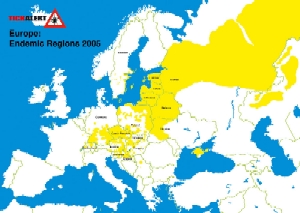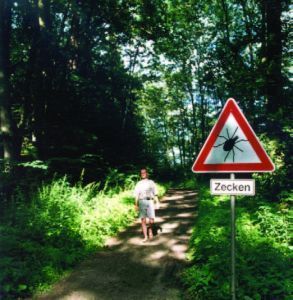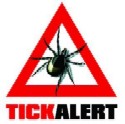Outdoor enthusiasts and holidaymakers planning trips to central and eastern Europe this year are being warned about a potentially life-threatening disease.

The 'Tick Alert' awareness campaign urges travellers to 16 named European countries, including many of the new popular destinations for outdoor tourism such as Croatia, Slovenia and Slovakia, to protect themselves against Tick Borne Encephalitis (TBE).
Increased tourism to rural and woodland areas of endemic countries in Europe is increasing the risk to visiting UK outdoor enthusiasts, the majority of whom remain unaware of the disease, how it is contracted or that they are members of a high-risk travel group.
TBE is a potentially life-threatening viral disease that can lead to meningitis and in serious cases can result in paralysis and death. It is transmitted via the bite of an infected tick, found typically in rural and forest areas up to a height of 3,000ft and occurs mainly during the late spring and summer months. The disease can also be transmitted by the ingestion of unpasteurised milk.
There has been a dramatic rise in the incidence of tick-borne diseases in central and eastern Europe over the last 10 years. TBE is now endemic in countries spreading from Sweden, across the Baltics and down to Croatia.
The fact that a number of endemic countries conduct intensive inoculation programmes for their resident populations should be heeded by all UK visitors.
“There is a low awareness of TBE, even among people experienced in outdoor activities abroad,” said Tick Alert's Lynda Bramham. “The aim of this campaign is to encourage anyone travelling to TBE endemic regions, and at risk of the disease through their outdoor leisure activity, to take effective precautions.”
Official figures show the number of UK tourists to the former Yugoslavia rose by 40 per cent last summer to 114,000 compared with the previous 12 months. Similarly, visitors to central and eastern Europe reached 558,000, an increase of 38 per cent.
 Adventure travel, hiking and mountain biking in Europe are all
increasing in popularity as people discover these new destinations.
Adventure travel, hiking and mountain biking in Europe are all
increasing in popularity as people discover these new destinations.
A 2004 report by Mintel highlighted the growth of agritourism and countryside holidays in places such as Croatia and Estonia, and the Association of British Travel Agents (ABTA) lists Slovenia and Bulgaria among its hot tips for holidays in 2005.
Professor Sarah Randolph, head of the Oxford Tick Research Group at the University of Oxford said: “In some countries of mainland Europe the most serious vector-borne disease is caused by a virus transmitted by ticks, tick-borne encephalitis (TBE), which may kill one in every hundred people infected.”
There are a number of bite prevention measures that can be taken to reduce the risk of infection: these include using an insect repellent, wearing protective clothing to cover all areas of exposed skin, regularly inspecting your body for tick bites and carefully removing any that are found. However, the Foreign Office advises that travellers to TBE endemic regions seek inoculation advice form their local surgery of clinic – well before travelling.
 Immunisation against TBE is available as a paid-for travel vaccine
from specialist travel health clinics operated by MASTA, the
UK's leading provider, and at GP surgeries and healthcare
centres. For further information and advice for travellers visit www.masta.org/tickalert
Immunisation against TBE is available as a paid-for travel vaccine
from specialist travel health clinics operated by MASTA, the
UK's leading provider, and at GP surgeries and healthcare
centres. For further information and advice for travellers visit www.masta.org/tickalert

 We are sorry to
say that Mac is not very well, but he is still e-mailing strong and
recently sent the Beetle a collection of travel reminiscences and
in particular discusses some travel writers. Former Globetrotter
President, Arthur Frommer (Europe On $5 A Day) gave an interesting
interview to travel writer Michael Shapiro for Michael's book,
We are sorry to
say that Mac is not very well, but he is still e-mailing strong and
recently sent the Beetle a collection of travel reminiscences and
in particular discusses some travel writers. Former Globetrotter
President, Arthur Frommer (Europe On $5 A Day) gave an interesting
interview to travel writer Michael Shapiro for Michael's book,